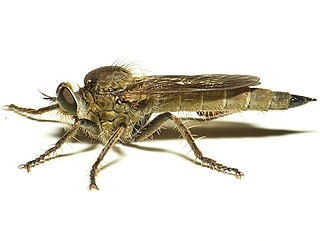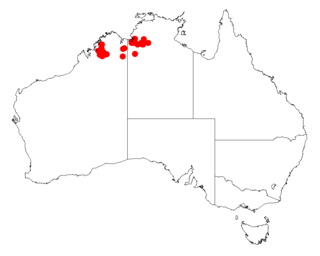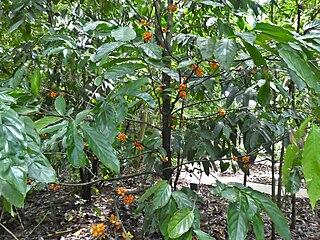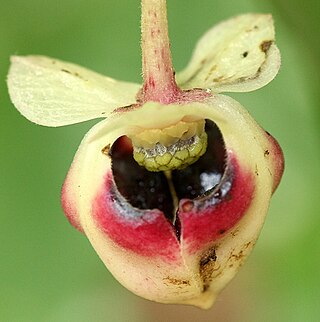
The Asiloidea comprise a very large superfamily insects in the order Diptera, the true flies. It has a cosmopolitan distribution, occurring worldwide. It includes the family Bombyliidae, the bee flies, which are parasitoids, and the Asilidae, the robber flies, which are predators of other insects.

The Asilidae are the robber fly family, also called assassin flies. They are powerfully built, bristly flies with a short, stout proboscis enclosing the sharp, sucking hypopharynx. The name "robber flies" reflects their expert predatory habits; they feed mainly or exclusively on other insects and, as a rule, they wait in ambush and catch their prey in flight.

The Therevidae are a family of flies of the superfamily Asiloidea commonly known as stiletto flies. The family contains about 1,600 described species worldwide, most diverse in arid and semiarid regions with sandy soils. The larvae are predators of insect larvae in soil.

Pseuduvaria is a genus of the plant family Annonaceae and tribe Miliuseae: with a native range is Tropical Asia.

Blepharotes splendidissimus is a robber fly in the family Asilidae found in eastern Australia. Recognised by its shiny black abdomen, it is the second largest of its genus. It was described by the German naturalist Christian Rudolph Wilhelm Wiedemann in 1830 as Laphria splendidissima.

Blepharotes coriarius, the giant yellow robber fly, is a species of large predatory fly from Australia in the family Asilidae. It was described by the German naturalist Christian Rudolph Wilhelm Wiedemann in 1830.

Dasypogoninae is a subfamily of robber flies in the family Asilidae. There are more than 60 genera and 520 described species in Dasypogoninae.
Chlorotachina is a genus of flies in the family Tachinidae.

Machimus is a genus of flies in the family Asilidae, the robber flies and assassin flies. They can be found nearly worldwide, except in Australia and New Zealand. Most are native to the Palearctic realm and southern Asia.
Ironomyiidae is a small family of flies in the order Diptera. Historically, they had been included in the family Platypezidae, and includes three extant species within the single extant genus Ironomyia endemic to Australia and a number of extinct fossil genera from North America and Asia extending back to the Early Cretaceous.

Laphriinae is a subfamily of robber flies in the family Asilidae. There are more than 110 genera and 1,000 described species in Laphriinae. Larvae of the genus Hyperechia are known to grow inside the cells of Xylocopa bees, feeding on their larvae.

Acacia froggattii is a shrub of the genus Acacia and the subgenus Plurinerves that is endemic to an area in north western Australia
Acacia obtriangularis, also commonly knowns as Lawley River wattle, is a shrub of the genus Acacia and the subgenus Plurinerves that is endemic to a small area of north western Australia.

Eucalyptus froggattii, commonly known as the Kamarooka mallee, is a species of mallee or small tree that is endemic to Victoria. It has rough, crumbly, blackish bark on the trunk, smooth grey to brown bark above, lance-shaped adult leaves, four-sided flower buds in groups of between seven and eleven, white or cream-coloured flowers and four-sided, cup-shaped to pear-shaped fruit.

Asilus is a genus of robber flies in the family Asilidae. There are at least 150 described species in Asilus.
Neodioctria is a genus of flies belonging to the family Asilidae.

Pseuduvaria froggattii is a rare species of tree which is restricted to a very small part of northeastern Queensland, Australia. It is a member of the custard apple and soursop family Annonaceae, and was first described in 1887. Despite the small range its status considered to be least concern.

Pseuduvaria mulgraveana is a species of plant in the family Annonaceae endemic to Queensland, Australia. L.W. Jessup, the botanist who first formally described the species, named it after the Mulgrave River, where the specimen he examined was collected.













